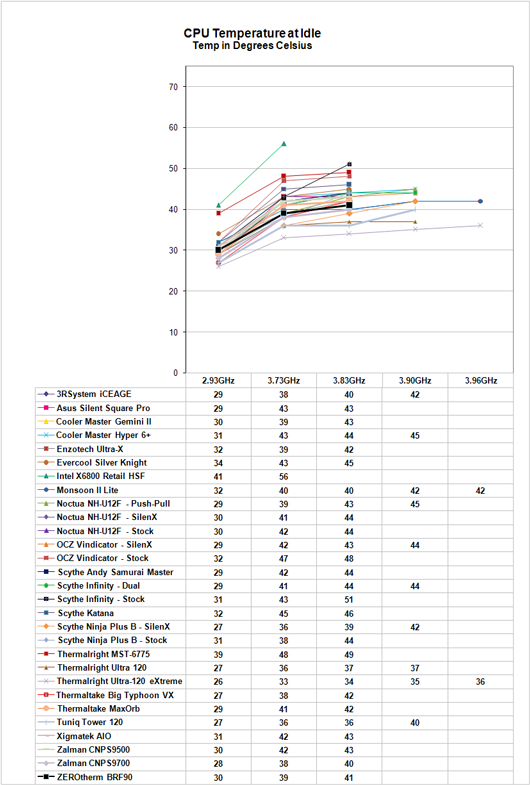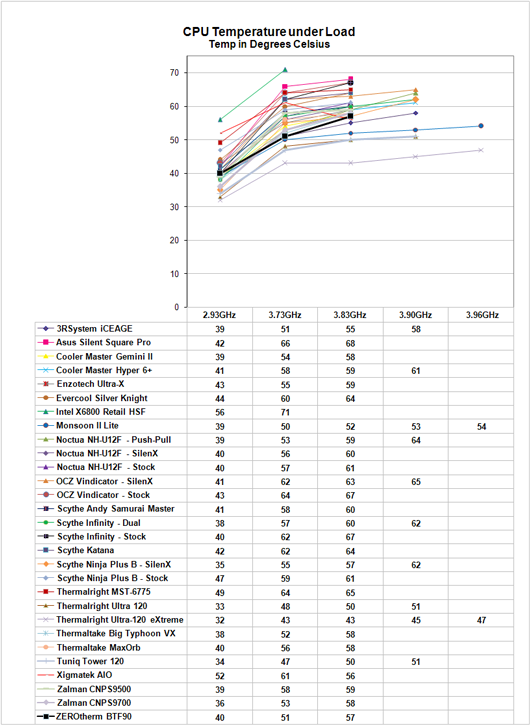ZEROtherm BTF90: Sting like a Butterfly?
by Wesley Fink on August 13, 2007 12:05 AM EST- Posted in
- Cases/Cooling/PSUs
Scaling of Cooling Performance
The BTF90 performance was average at both stock idle and stock load compared to other top coolers tested at AnandTech. Keeping in perspective that a 92mm fan drives the BTF90 compared to the 120mm fans used on most other coolers, this performance would have to be considered very good. As overclocks are raised, the ZEROtherm exhibits improved performance in the ability to cool the CPU under stress conditions.
At 2.93GHz the retail HSF is running at 41C, compared to 30C with the BTF90. This is a delta of 11C. The delta becomes greater as the overclock increases. At 3.73GHz the idle with the retail fan is 56C compared to the Ultra-X at 39C - a delta of 17C. The cooling performance of the BTF90 is much better than the Intel retail cooler at idle, but the ZEROtherm does not reach the same cooling levels measured with the Thermalrights (with a Scythe S-Flex SFF21F fan) or the stock Tuniq 120. The top Thermalright Ultra-120 eXtreme, for example, is at 33C at the same 3.73GHz.
We also need to compare cooling efficiency of the ZEROtherm BTF90 under load conditions to the retail HSF and other recently tested CPU coolers. Load testing can be very revealing of a cooler's efficiency. A basically flat line, particularly form 3.73GHz upward, indicates the cooler is still in its best cooling range. A line that is increasing rapidly indicates a cooler nearing the end of its ability to cool efficiently. Lines which parallel the best coolers over a range of values are indicate that the coolers have similar cooling efficiency.
The BTF90 is very efficient in cooling in the 2.93 GHz to 3.73 GHz overclock range. The BTF90 continues on to a highest overclock of 3.83GHz, but the cooling curve is much steeper in this area, suggesting the BTF90 is losing cooling efficiency. The BTF90 falls short of the 3.90GHz to 3.94GHz most of the top coolers in our testing have achieved, but it is also cooling with a smaller fan with a smaller output than the other coolers. It also manages this with relative quiet, as seen in the noise tests.
As stated many times, the overclocking abilities of the CPU will vary at the top, depending on the CPU. This particular CPU does higher FSB speeds than any X6800 we have tested, but the 3.90GHz top speed with the Tuniq is pretty average among the X6800 processors we have tested with Tuniq cooling. A few of the other processors tested with the best air coolers reach just over 4 GHz, but the range has been 3.8 to 4.0GHz. Stock cooling generally tops out 200 to 400 MHz lower, depending on the CPU, on the processors tested in our lab.
The BTF90 performance was average at both stock idle and stock load compared to other top coolers tested at AnandTech. Keeping in perspective that a 92mm fan drives the BTF90 compared to the 120mm fans used on most other coolers, this performance would have to be considered very good. As overclocks are raised, the ZEROtherm exhibits improved performance in the ability to cool the CPU under stress conditions.
 |
| Click to enlarge |
At 2.93GHz the retail HSF is running at 41C, compared to 30C with the BTF90. This is a delta of 11C. The delta becomes greater as the overclock increases. At 3.73GHz the idle with the retail fan is 56C compared to the Ultra-X at 39C - a delta of 17C. The cooling performance of the BTF90 is much better than the Intel retail cooler at idle, but the ZEROtherm does not reach the same cooling levels measured with the Thermalrights (with a Scythe S-Flex SFF21F fan) or the stock Tuniq 120. The top Thermalright Ultra-120 eXtreme, for example, is at 33C at the same 3.73GHz.
We also need to compare cooling efficiency of the ZEROtherm BTF90 under load conditions to the retail HSF and other recently tested CPU coolers. Load testing can be very revealing of a cooler's efficiency. A basically flat line, particularly form 3.73GHz upward, indicates the cooler is still in its best cooling range. A line that is increasing rapidly indicates a cooler nearing the end of its ability to cool efficiently. Lines which parallel the best coolers over a range of values are indicate that the coolers have similar cooling efficiency.
 |
| Click to enlarge |
The BTF90 is very efficient in cooling in the 2.93 GHz to 3.73 GHz overclock range. The BTF90 continues on to a highest overclock of 3.83GHz, but the cooling curve is much steeper in this area, suggesting the BTF90 is losing cooling efficiency. The BTF90 falls short of the 3.90GHz to 3.94GHz most of the top coolers in our testing have achieved, but it is also cooling with a smaller fan with a smaller output than the other coolers. It also manages this with relative quiet, as seen in the noise tests.
As stated many times, the overclocking abilities of the CPU will vary at the top, depending on the CPU. This particular CPU does higher FSB speeds than any X6800 we have tested, but the 3.90GHz top speed with the Tuniq is pretty average among the X6800 processors we have tested with Tuniq cooling. A few of the other processors tested with the best air coolers reach just over 4 GHz, but the range has been 3.8 to 4.0GHz. Stock cooling generally tops out 200 to 400 MHz lower, depending on the CPU, on the processors tested in our lab.










19 Comments
View All Comments
angelicvoices - Friday, March 20, 2009 - link
I have this cooler and I am trying to remove the red LEDs. I can see from your shots where they're supposed to be but I can't actually see them on my cooler. Any help would be appreciated.andereandre - Tuesday, August 14, 2007 - link
my main interest in getting a new cooler, is lowering the noise.Now in these articles the Intel HSF is always classified the same as the best coolers (and system-ps & no fans).
That would suggest that would I be an Intel user, I would not gain anything by replacing it.
I have a X2 4600 however, and I hear the AM2 stock cooler at idle.
Does this mean that de Intel stock cooler is that much better than the AMD one, or is it just the measurement?
I am just worrying that getting me a cooler like this one would not bring me what I am after.
Jodiuh - Monday, August 13, 2007 - link
It's a #$#%ing butterfly on your pc...are you serious?Thinkitect - Monday, August 13, 2007 - link
Why compare this cooler to the Tuniq in the conclusion? It's a different product serving a different purpose. It's like trying to arrange a fight between a heavyweight boxing championship contender with a medium weight rookie.It's fine to put the larger coolers on the same performance graphs to see the difference between categories and price ranges, but for the conclusion and main comparison you should have used the directly competing ones. For example the AC Freezer 7 Pro and the Scythe Ninja Rev.B are popular in the price range (from researching for an HSF last month) - which one of the three outperforms the others? That could have been a sensible conclusion.
Your reviews have a purpose - meaningful and accurate comparisons between products. You are doing an excellent job with the research and data presentation, please get the written analysis on the level. Thank you.
Wesley Fink - Monday, August 13, 2007 - link
Sites like Tiger Driect and Amazon still show the BTF90 selling price as $60, which means it competes at the top. That is why we tried to carefully point out the plus and minus points of the BTF90 compared to the Thermalrights and Tuniq. The BTF90 does not compete that well at the $60 price point.However, at its current selling price of $35 to $45 (after rebate) we think it competes very well and is worth considering.
Spanki - Monday, August 13, 2007 - link
Good article - It's nice to see you broadening your views (audience) somewhat :). If you really want to see bang-for-buck performance, I wish you'd add some like the CoolerMaster Hyper Tx (http://www.svc.com/rr-pch-s9u1-gp.html">for ~$15.00) and/or the Arctic Cooler Freezer 7 Pro (http://www.svc.com/acfzp7.html">generally available for ~$20-$25) to the lineup.Not everyone wants to spend ~$60 - $$80 (or more) on a HSF, so it would be nice to see where these cheaper coolers fall by comparison - of course the results will embarrass some of the higher dollar coolers - but that's kinda the point, isn't it? You don't always get what you pay for.
strikeback03 - Tuesday, August 14, 2007 - link
From tests I have seen, I'd guess the Freezer 7 would be the embarrassed one, but whatever.Wesley Fink - Monday, August 13, 2007 - link
We have added the following info to the overclocking page to put the analysis of this cooler and others in cleare perspective:"There is no doubt that the BTF90 is able to dissipate 150W or more of heat. This merely points out the extreme demands that our overclocking cooling tests make of coolers while we push an X6800 processor to its overclock limits. The power requirements of a Core 2 Duo X6800 processor at rated speed and voltage is around 75 watts. At the overclocked speed of 3.830GHz at the commonly required 1.5375V to 1.5625V the wattage has doubled - to 148W to 153W. At the highest air OC with this X6800 of 3.94GHz with a Thermalright Ultra 120 eXtreme wattage has risen to 165W to 168W.
The stock Intel Retail cooler is really an excellent cooler, and the requirement that a tested cooler must perform better than the included Intel cooler is more demanding than you might think. THe Intel stock cooler topped out at 3.73 GHz at just below 1.5V. This means the stock Intel cooler is dissipating 135W at the highest overclock it could reach. These figures should help keep in perspective the relative efficiency of the coolers being tested and the extreme conditions of our maximum overclock cooling test bed."
RamarC - Monday, August 13, 2007 - link
the 'float like a butterfly' citation on the last page should be corrected.Wesley Fink - Monday, August 13, 2007 - link
The citation has always been Mohammed Ali. The word parsing puts the Ali at the start of the next line.